Intro
Learn about Uterine Artery Embolization, a minimally invasive procedure treating fibroids and heavy bleeding, using embolization techniques and interventional radiology for effective relief.
The uterine artery embolization procedure has gained significant attention in recent years as a minimally invasive treatment option for various gynecological conditions, particularly for uterine fibroids. This procedure has been shown to be effective in reducing symptoms and improving the quality of life for many women. As a result, it is essential to understand the importance of this procedure and its potential benefits. The uterine artery embolization procedure is a medical intervention that involves blocking the blood flow to the uterus, which can help to shrink fibroids and reduce symptoms such as heavy bleeding and pain. This procedure is typically performed by an interventional radiologist, who uses imaging guidance to insert a small catheter into the uterine artery and deliver tiny particles that block the blood flow.
The uterine artery embolization procedure is often considered a viable alternative to traditional surgical options, such as hysterectomy, which can be invasive and may result in significant recovery time. In contrast, the uterine artery embolization procedure is typically performed on an outpatient basis, and most women can return to their normal activities within a few days. Additionally, this procedure can be customized to address the specific needs of each patient, taking into account the size, location, and number of fibroids present. As a result, the uterine artery embolization procedure has become an attractive option for many women seeking to manage their symptoms and improve their overall health.
The potential benefits of the uterine artery embolization procedure are numerous, and it is essential to understand the working mechanisms and steps involved in this procedure. By blocking the blood flow to the uterus, the uterine artery embolization procedure can help to shrink fibroids, reduce heavy bleeding, and alleviate pain. This procedure can also help to improve the overall quality of life for many women, allowing them to return to their normal activities and enjoy a more active lifestyle. Furthermore, the uterine artery embolization procedure can be used to treat other gynecological conditions, such as adenomyosis and uterine bleeding, making it a versatile and effective treatment option.
What is Uterine Artery Embolization?
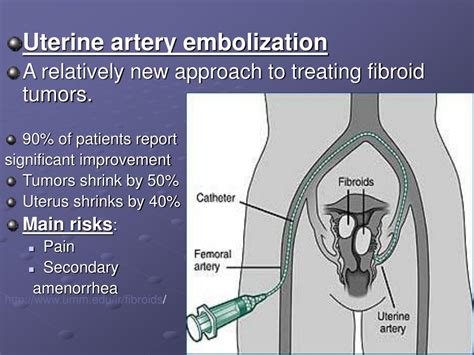
Benefits of Uterine Artery Embolization
The benefits of uterine artery embolization are numerous, and they include: * Reduced symptoms: Uterine artery embolization can help to shrink fibroids and reduce symptoms such as heavy bleeding and pain. * Minimally invasive: This procedure is typically performed on an outpatient basis, and most women can return to their normal activities within a few days. * Customizable: Uterine artery embolization can be customized to address the specific needs of each patient, taking into account the size, location, and number of fibroids present. * Improved quality of life: Uterine artery embolization can help to improve the overall quality of life for many women, allowing them to return to their normal activities and enjoy a more active lifestyle.How is Uterine Artery Embolization Performed?
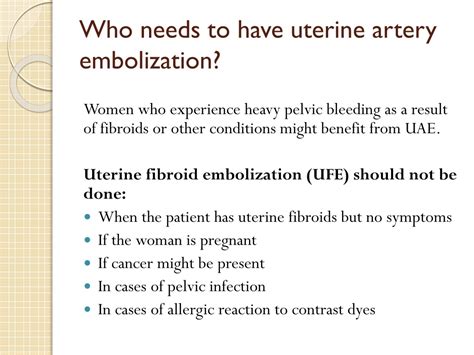
Risks and Complications
As with any medical procedure, there are risks and complications associated with uterine artery embolization. These include: * Pain: Some women may experience pain or discomfort after the procedure. * Infection: There is a small risk of infection with any medical procedure. * Allergic reaction: Some women may be allergic to the particles used in the procedure. * Injury to surrounding organs: There is a small risk of injury to surrounding organs, such as the bladder or bowel.Who is a Candidate for Uterine Artery Embolization?
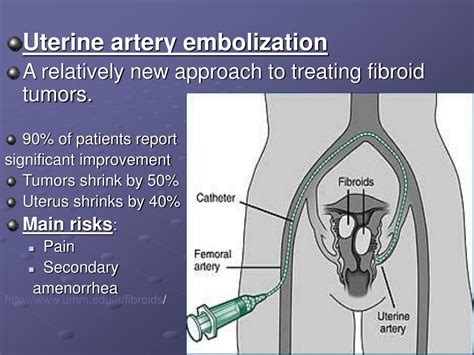
What to Expect After the Procedure
After the uterine artery embolization procedure, women can expect to experience some symptoms, such as: * Pain or discomfort: This is usually mild and can be managed with pain medication. * Fatigue: Women may feel tired or fatigued after the procedure. * Bleeding: Women may experience some bleeding or spotting after the procedure. * Cramping: Women may experience some cramping or discomfort after the procedure.Recovery and Follow-up
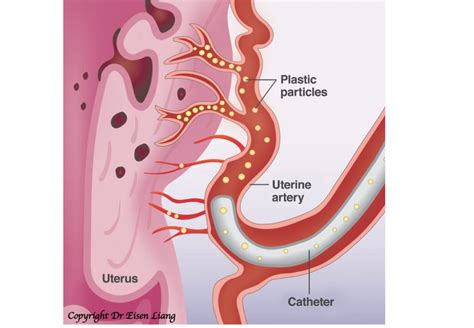
Long-term Results
The long-term results of uterine artery embolization are typically positive, with many women experiencing significant improvement in their symptoms. However, it is essential to note that the results can vary depending on the individual and the severity of the condition being treated. In general, women can expect to experience: * Reduced symptoms: Uterine artery embolization can help to shrink fibroids and reduce symptoms such as heavy bleeding and pain. * Improved quality of life: Uterine artery embolization can help to improve the overall quality of life for many women, allowing them to return to their normal activities and enjoy a more active lifestyle.Conclusion and Next Steps
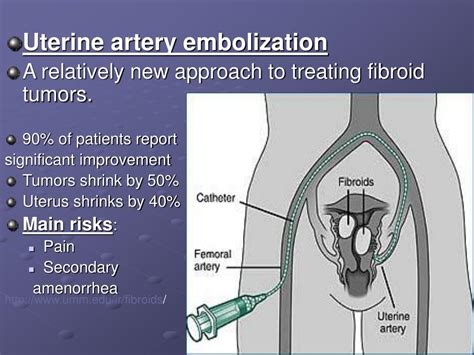
What is uterine artery embolization?
+Uterine artery embolization is a minimally invasive procedure that involves blocking the blood flow to the uterus to shrink fibroids and reduce symptoms.
Who is a candidate for uterine artery embolization?
+Uterine artery embolization is typically recommended for women who have symptomatic uterine fibroids, adenomyosis, or uterine bleeding, and are seeking a minimally invasive treatment option.
What are the risks and complications of uterine artery embolization?
+The risks and complications of uterine artery embolization include pain, infection, allergic reaction, and injury to surrounding organs.
We hope this article has provided you with a comprehensive understanding of uterine artery embolization and its potential benefits. If you have any further questions or would like to learn more about this procedure, please do not hesitate to comment below or share this article with others.
